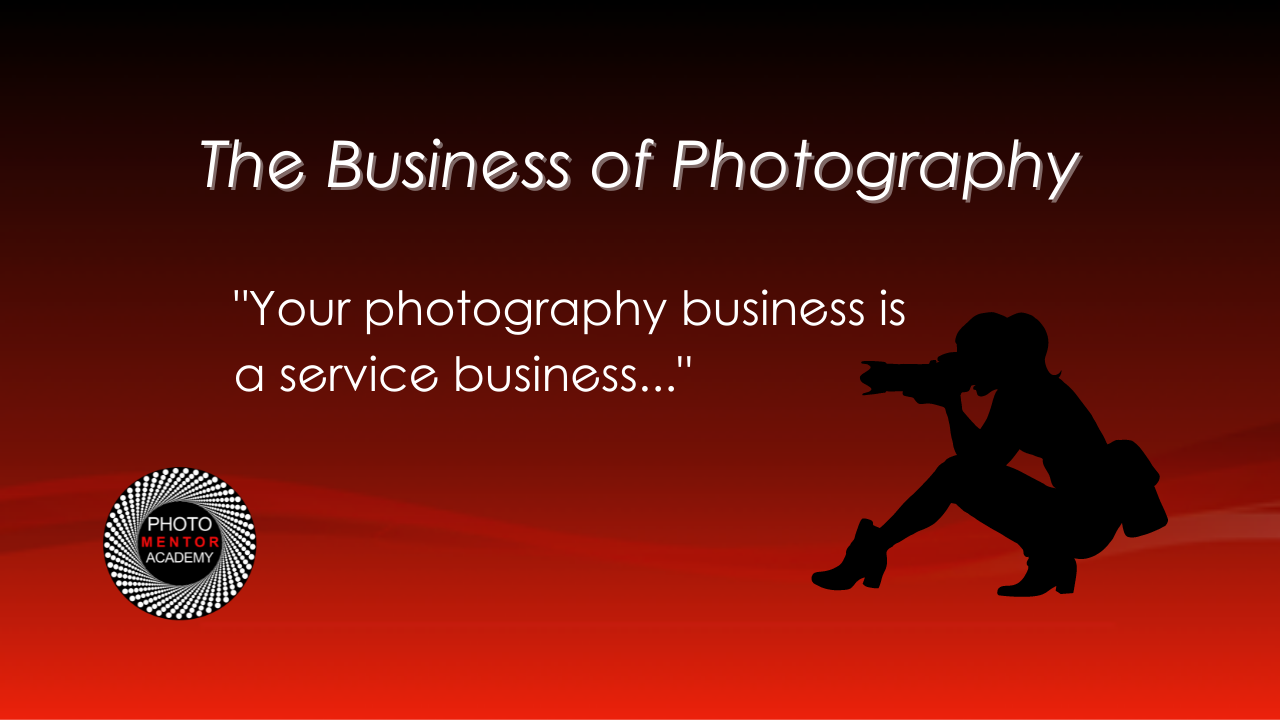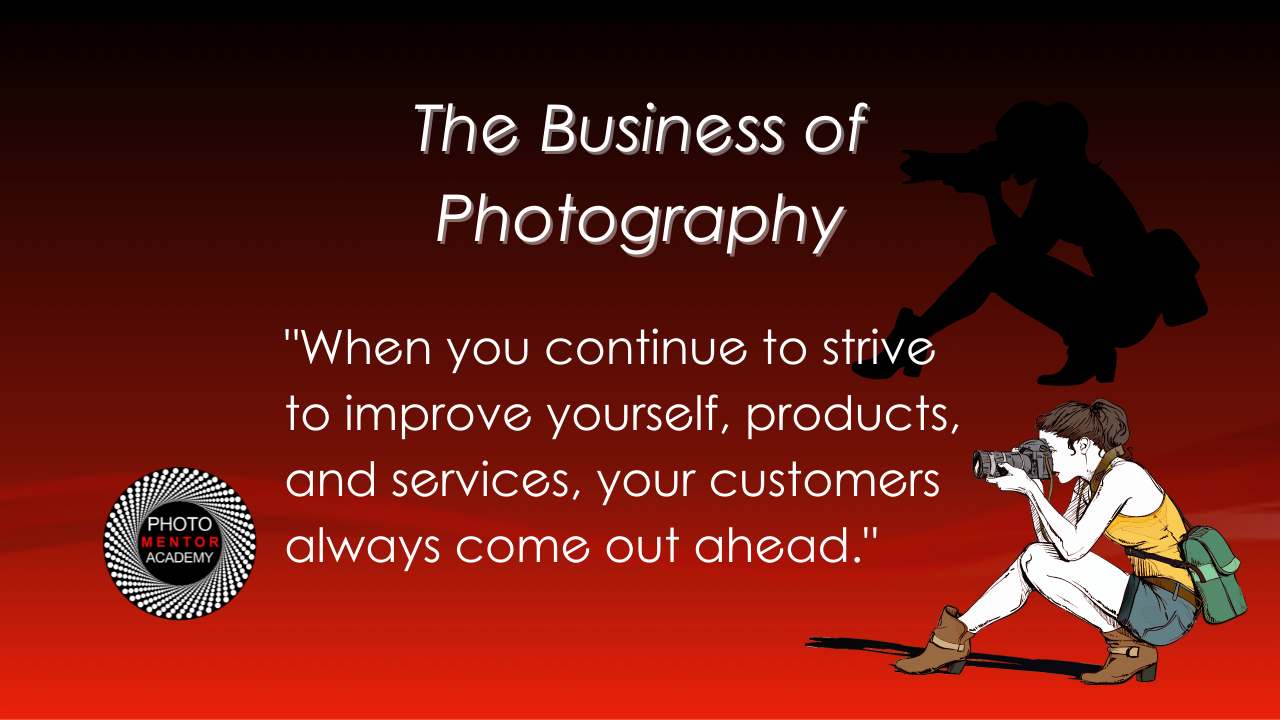Beyond the Perfect Shot: The Business of Photography
Oct 15, 2021
When your Photo Mentor, Lee Love, talks about the business of photography, he has a few perspectives that may surprise you.
Lee repeatedly stresses the importance of recognizing the significance of genuinely understanding a client’s needs and desires in his LIVE shows for Photo Mentor Academy.
And that, dear reader, is the first lesson in distinguishing your photography practice as a business vs. a hobby or personal passion. When your photography turns into a business, it’s no longer about what you want to shoot but about what the client wants to see.
As a professional photographer, you no longer take photos whenever you feel like it because now you must meet customer needs and show up as scheduled, prepared, and ready. In other words, your customers and their work take precedence.
Being an artist on-demand is tougher but, top photographers make it look easy. Your job is to make it look easy and make your subjects feel relaxed and at ease when you shoot them.
Therefore, it’s essential to understand your photography business as a services business. And of course, as in any services company, people skills are at the top of the list for what you need to do well.
One way to hone your people skills is to do a little prep work by researching your subject or subject matter before shooting. This kind of legwork allows you to gain valuable insights going into the project, sure to impact your results in a positive direction. It also gives you a chance to connect with your subjects, making them more comfortable working with you.
When people like and feel comfortable with you, they’re more likely to hire you.
Actions Are Your Brand
Okay, so, here’s the thing.
I believe you build a personal brand by the actions you take and how you conduct business. So, in a way, you act your way into creating, molding, and establishing who you are as a business and brand.
Your brand reveals itself to others when you lead by demonstrating your core values and incorporating personality and expertise into your work.
By consistently and continuously proving this integrity through the actions you take—the quality you provide in your business and relationships—the more robust your personal brand becomes, and others readily recognize it, as well.
So, briefly, that’s how to build a solid personal brand. Interestingly, this organically happens if you are pure in your desire to do and be the best you possibly can be as a business and person.
Trust follows by establishing your skills and integrity as a professional photographer and understanding your clients’ needs. As you build more trust in developing a valuable brand, your business also becomes in demand.
In-demand photographers enjoy the ability to charge more for their work, without question. They’re given more creative freedom due to their trustworthiness and credibility and based on strong human-to-human relationships.
Lee points out the weight of these business-building actions and customer services and skills. He warns that they account for about eighty percent of your photography business work, leaving only about twenty percent of your time for taking photos!
Because there are a lot of moving parts in running a successful small business, this point is crucial to consider. It also means you need to adopt a business mindset.
You may be an artist, a creative, a photographer, but making your art a business means you need a realistic outlook to create success.

Problem-Solving Wins Not Your Fab Shots
Keeping in mind you are in a service business, Lee discounts the importance of the gear you use, shifting the focus from photography to problem-solving. He explains how solving problems is a repetitive theme for almost every client and every shoot.
Thinking on your feet and staying flexible in dealing with environmental or other factors that occur makes you a go-to resource, reliable in any situation, and trusted for your abilities.
Again, these issues and others require emotional intelligence, people skills, and creativity to solve. Much of your business acumen has nothing to do with photography and everything to do with thinking, intuition, and ingenuity instead.
Solving people’s problems and getting to know them personally helps you establish the kind of working rapport people love. And, come to rely on for their project needs.
Therefore, establishing quality business relationships is the golden rule to repeat customers and the best PR or advertising of all, word-of-mouth!
Businesses in every industry are built on word-of-mouth advertising alone. Plus, today’s personal use of technology and social media amplifies word-of-mouth further, and faster than ever before.
All of these customer-centric components are foundational to building your brand’s reputation and gaining business. In an apples-to-apples product/service comparison, it’s the way you act as a brand—based on trust, reliability, credibility, and working relationships—that tips the scales for the win.
I guess the people-power in business, even the photography business where the image capture is the actual product, supports Lee’s stance that your camera or gear isn’t as crucial as first it appears.
Customer Care
The thing is, you are more aware of your camera, lens, and gear. You are more aware of lighting and bokeh and technical capabilities in post-processing. And you are more critical of every single detail for each shot you take for a client by far more than they are. So relax.
But go ahead and continue to push yourself to the highest standard. When you strive to improve yourself, products, and services, the customers always come out ahead. Still, it’s perfectly fine to continue to learn, hone your skills, and improve while operating an excellent and viable business.
As Lee often says, “We all have to start somewhere.” Of course, the services you offer and your pricing structure reflect your experience and abilities.
And while your prices will grow with your project successes, favorable reputation, experience, and expertise, you need to be aware of your income/expense statement from the beginning. A business is only a business if you earn money from operations.
Initial profit margins for a business are usually not optimal, and there are startup expenses as well. But, there’s nothing wrong with starting meagerly, keeping costs under wraps, and increasing expenditures only as revenue grows.
Lee suggests establishing an exact “Scope of Project” for each client’s order to keep project costs at acceptable levels.
Define what your customer needs, so they know your understanding of the project or work request. Then specifically describe what you are going to provide. Finally, offer a budget breakdown for their review/approval.
This simple process for a service proposal helps you control costs and meet customer expectations. Additionally, this practice lets you understand clients and their needs and the costs of doing business, so you can improve your service offers as you go.

Defining Your Service Position
Lee talks about identifying your niche or primary genre of photography and making it obvious when a person visits your website or views your portfolio. You need to announce it loud and clear, preferably by showcasing your work, so people immediately know what you excel at and what you offer.
This is especially important when starting. Specialization helps you stand out and get noticed. It allows you to price “specialty” services higher. Having a genre where you are outstanding and are perhaps more familiar enables you to be known in your field.
Photography offers a lot of possibilities for you; however, it’s a good idea to hone in on two things to get started;
1- what do you like to shoot?
2- who do you want to work for?
Your photography business products and services, positioning and pricing, marketing and promotions, website and social media are all intimately informed by dissecting and understanding these answers.
And again, as Lee mentions in many of his LIVE broadcasts, niching is a great way to attract the right audience, grow your reputation, and charge higher fees. For photographers, it’s a solid business model.
So much so, Lee suggests separate websites for professional and personal collections, or even for the different kinds of photography you offer. In other words, work to specifics because, as an example, talking to business vs. personal clients are two completely different things.
Remember, if you’re selling photography, your audience and the user experience (UX) you provide matters.
Your Customers Run the Show
Clarifying what you sell and who your customers are guides your digital messaging. Further, it gives direction for your business model, both digitally and otherwise.
Lee often emphasizes the significance of genuinely understanding your customers’ needs, so you give them what they crave.
Deliver a memory, a story, a place in time for them to cherish.
Lee says the ability to connect with your clients and provide what they want, over your personal artistic and photographic preferences, defines you as a business.
So, focus on:
- addressing client needs,
- learning their priorities,
- solving problems as they arise,
- and building solid relationships.
Next, define deliverables and set expectations of what you will do for a project, detail the budget, terms, and confirm dates and times. Don’t be afraid to ask questions, so you are sure everyone is on the same page and to eliminate any room for misunderstandings.
Follow through by meeting schedules and making deadlines. Maintain a customer-first and quality-first approach to business. Strive to over-deliver. And work to continue to develop your skills and talents, and education in photography.
When professionalism, experience, and knowledge in your field (finally, the photography part!) make you a go-to resource for your clients, trust in your services grows faster. But Lee contends this element is icing on a solid foundation built first on understanding (what you do/shoot) YOU, and secondly, by understanding (the needs and desires of) YOUR CUSTOMERS.
It’s understandable to want to hone your craft and emphasize growing as an artist with your photography work. But, to make catching those memorable shots a career, you need to adopt a business mindset.
A little thought and analysis go a long way in allowing you to take a strategic approach to your photography business. But overall, your Photo Mentor, Lee Love, strongly suggests you focus on solving problems for people. By serving people as your priority in business, you set the foundation to thrive and grow.


